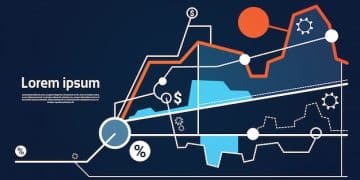Data Analytics for Business Growth: Leveraging Insights for Decision-Making

Strategic data analytics for business growth: leveraging insights to improve decision-making offers organizations the unparalleled ability to transform raw data into actionable intelligence, enabling more informed and effective choices that drive sustainable competitive advantage.
In today’s fast-paced corporate environment, the capacity for businesses to adapt and innovate hinges significantly on how effectively they utilize information. Data analytics for business growth: leveraging insights to improve decision-making is no longer just an advantage; it is a fundamental pillar for success. This process empowers organizations to move beyond mere guesswork, grounding their strategies in tangible evidence derived from comprehensive data sets.
The Foundational Role of Data Analytics
Data analytics has rapidly evolved from a niche technical function into a core strategic capability for enterprises aiming for sustainable expansion. At its heart, data analytics for business growth involves examining raw data with powerful tools and methodologies to discover trends, correlations, and patterns that can inform critical decisions. It transforms sheer volume into genuine value, enabling companies to predict market shifts, understand customer behavior, and optimize internal operations with precision. This shift toward data-centric operations marks a profound departure from traditional, intuition-based decision-making, providing a more robust and reliable pathway to achieving business objectives.
From Raw Data to Actionable Insights
The journey from raw data to actionable insights is complex but incredibly rewarding. It begins with data collection, covering everything from customer transactions and website interactions to supply chain logistics and social media engagement. Once collected, this data undergoes a meticulous cleaning and processing phase to ensure accuracy and consistency. The real power then emerges as advanced analytical techniques—ranging from descriptive and diagnostic analytics to predictive and prescriptive models—are applied. These techniques help businesses not only understand what happened and why but also what is likely to happen and what actions should be taken.
- Descriptive Analytics: Summarizes past data to tell “what happened.” This includes reporting, dashboards, and basic visualization to understand historical performance.
- Diagnostic Analytics: Explores data to determine “why something happened.” Techniques like drill-down, data discovery, and data mining are used to uncover causal relationships.
- Predictive Analytics: Aims to forecast “what will happen” in the future. This involves statistical models, machine learning, and forecasting techniques to anticipate outcomes.
- Prescriptive Analytics: Recommends “what should be done.” Leveraging optimization and simulation, it suggests specific actions to achieve desired results or mitigate risks.
The application of these analytical layers provides a holistic view of the business landscape, allowing leaders to make proactive decisions rather than reactive ones. For instance, predictive analytics can help anticipate customer churn, enabling businesses to implement retention strategies before it’s too late. Similarly, prescriptive analytics can optimize pricing strategies based on demand forecasts and competitive analysis. These capabilities collectively underpin a more agile and responsive business model.
The Strategic Imperative for Growth
Embracing data analytics is not merely about gaining efficiencies; it is about cultivating a strategic imperative for continuous growth. Businesses that successfully leverage data insights are better positioned to identify new market opportunities, enhance product development, and refine their marketing efforts. Data-driven growth strategies inherently lead to a deeper understanding of the evolving market dynamics and customer needs, fostering innovation that resonates with the target audience. Ultimately, effective data analytics transforms data from a byproduct of operations into a vital asset, driving sustained economic value and market leadership. The ability to measure, predict, and influence outcomes through data empowers organizations to confidently navigate uncertainty and build a resilient future.
Enhancing Customer Experience and Retention
A cornerstone of sustained business growth lies in cultivating strong, lasting relationships with customers. Data analytics plays an indispensable role in achieving this by providing deep insights into customer behavior, preferences, and pain points. By meticulously analyzing customer data—from purchase history and browsing patterns to feedback and support interactions—businesses can craft highly personalized experiences that resonate more deeply with their audience. This level of understanding enables organizations to anticipate needs, resolve issues proactively, and tailor communications, fostering a sense of value and loyalty among their clientele.
Personalization Through Data Insights
The era of one-size-fits-all marketing is long gone. Modern consumers expect personalized interactions, and data analytics makes this possible. By segmenting customers based on demographics, behavioral patterns, and previous interactions, businesses can develop targeted marketing campaigns, recommend relevant products or services, and offer bespoke promotions. For example, an e-commerce platform might use predictive analytics to suggest products a customer is likely to purchase next, based on their past buying habits and the browsing behavior of similar customers. This bespoke approach not only enhances the customer’s shopping experience but also significantly increases conversion rates and customer satisfaction. The more precise the personalization, the stronger the connection built with the customer, leading to higher engagement and loyalty.
Improving Customer Service and Support
Beyond sales and marketing, data analytics revolutionizes customer service and support operations. By analyzing customer support tickets, call logs, and social media mentions, businesses can identify recurring issues, understand common complaints, and pinpoint areas where service delivery might be falling short. This diagnostic capability allows companies to implement targeted improvements, streamline support processes, and ultimately reduce resolution times. Furthermore, predictive analytics can be used to identify customers who are at a higher risk of churning, enabling customer success teams to intervene proactively with tailored solutions or special offers, thereby preventing dissatisfaction from escalating into customer loss.

For instance, a telecommunications company might analyze call center data to identify common technical problems that lead to high call volumes. Armed with this insight, they could develop self-service troubleshooting guides or improve their network infrastructure, reducing the need for customers to call in the first place. This improves efficiency and elevates the overall customer experience by minimizing friction.
Driving Loyalty and Reducing Churn
Customer retention is often more cost-effective than customer acquisition. Data analytics provides the tools to understand why customers stay and, more critically, why they leave. By analyzing churn indicators such as declining engagement, reduced purchase frequency, or negative feedback, businesses can develop sophisticated churn prediction models. These models enable timely interventions, such as personalized outreach, loyalty programs, or exclusive offers designed to re-engage at-risk customers. The insights gained also inform product development and service improvements, ensuring that offerings continuously meet and exceed customer expectations, thereby solidifying loyalty and ensuring long-term relationships. This cycle of analysis, intervention, and improvement is vital for building a stable and growing customer base, turning data into a powerful asset for enduring business success.
Optimizing Operations and Efficiency
Operational efficiency is the lifeblood of any thriving business. In an increasingly competitive landscape, leveraging data analytics to streamline processes, reduce waste, and enhance productivity is paramount. Data analytics provides an unparalleled lens through which organizations can meticulously scrutinize their internal workings, from supply chain management and inventory control to workforce allocation and resource utilization. By identifying bottlenecks, inefficiencies, and areas of potential improvement, businesses can implement data-driven strategies that lead to significant cost savings and improved operational agility. This systematic approach ensures that resources are deployed effectively, leading to leaner, more responsive, and more profitable operations.
Streamlining Supply Chain and Inventory
The supply chain is a complex web of activities, and any disruption or inefficiency can have far-reaching consequences. Data analytics offers powerful solutions for optimizing every facet of the supply chain, from sourcing raw materials to delivering finished products. Predictive analytics can forecast demand with greater accuracy, allowing businesses to optimize inventory levels, minimizing both excess stock and stockouts. Geographic information systems (GIS) combined with transportation data can optimize logistics routes, reducing fuel consumption and delivery times. Furthermore, analyzing supplier performance data helps identify reliable partners and negotiate better terms, ensuring a more resilient and cost-effective supply chain. For example, a retail company might use historical sales data and weather patterns to predict demand for seasonal clothing, adjusting their orders from manufacturers to match anticipated sales, thereby reducing unsold inventory and associated carrying costs.
Enhancing Workforce Management
A company’s workforce is one of its most valuable assets, and optimizing its management through data analytics can yield substantial benefits. By analyzing employee performance data, attendance records, and engagement metrics, organizations can identify training needs, optimize shift scheduling, and improve overall productivity. Predictive analytics can even help forecast staffing requirements, ensuring that businesses have the right number of employees with the right skills at the right time. This not only enhances operational efficiency but also contributes to a more engaged and satisfied workforce by preventing burnout and ensuring equitable workload distribution. Understanding employee sentiment through survey data and text analytics can also reveal underlying issues that impact morale and productivity, allowing for targeted interventions that create a more positive work environment.
Cost Reduction and Resource Optimization
One of the most immediate and tangible benefits of leveraging data analytics for operational optimization is cost reduction. By deeply analyzing operational data, businesses can pinpoint areas where resources are being underutilized or wasted. This could involve identifying energy inefficiencies in manufacturing processes, optimizing equipment maintenance schedules to prevent costly breakdowns, or even pinpointing redundant software subscriptions. Data-driven insights enable organizations to make informed decisions about resource allocation, ensuring that every dollar spent contributes effectively to business objectives. For example, a manufacturing plant might use sensor data from its machinery to predict when maintenance is needed, shifting from a fixed maintenance schedule to a predictive one, which reduces downtime, extends asset life, and lowers overall maintenance costs. This meticulous approach to resource management ensures that operational investments yield maximum returns, contributing directly to the bottom line.
Strategic Decision-Making and Risk Mitigation
In an environment characterized by rapid change and inherent uncertainties, the ability to make informed strategic decisions and effectively mitigate risks is paramount for business longevity and growth. Data analytics transforms this process from an intuitive gamble into a calculated play, providing the foresight necessary to navigate complex market dynamics. By systematically analyzing vast datasets, organizations can identify emerging opportunities, anticipate potential threats, and assess the likely outcomes of various strategic choices, enabling more confident and impactful leadership. This proactive approach not only minimizes exposure to adverse events but also maximizes the potential for sustainable competitive advantage.
Identifying Market Trends and Opportunities
Understanding the market is a perpetual challenge for businesses. Data analytics, particularly through techniques like market basket analysis and sentiment analysis, allows companies to discern subtle shifts in consumer preferences, identify nascent trends, and pinpoint underserved segments. By analyzing social media discussions, news articles, and competitive intelligence, businesses can gain a comprehensive understanding of the external landscape. This insight is crucial for product development, market entry strategies, and identifying strategic partnerships. For instance, a footwear company might analyze data on trending fashion apparel and athletic activities to identify a demand for cross-functional trainers, leading to a new product line that captures a growing market segment. Such foresight, powered by data, enables businesses to be pioneers rather than followers.
Forecasting Future Performance
Predicting the future with precision is a core aspiration of strategic planning. Predictive analytics, utilizing sophisticated statistical models and machine learning algorithms, can forecast sales revenues, market share, and operational costs with remarkable accuracy. These forecasts are invaluable for setting realistic goals, allocating budgets, and developing robust business plans. By analyzing historical performance data in conjunction with external factors like economic indicators and seasonal trends, businesses can develop dynamic models that adapt to changing conditions. This capacity to project future performance empowers leaders to make proactive adjustments to their strategies, mitigating potential shortfalls and capitalizing on anticipated surges. A financial service firm, for example, might use predictive models to forecast loan default rates based on economic indicators and borrower credit scores, enabling them to adjust their lending criteria and minimize risk.
Assessing and Mitigating Risks
Risk management is an continuous endeavor for any enterprise. Data analytics provides powerful tools for identifying, assessing, and mitigating a wide array of business risks, from financial volatility and operational outages to cybersecurity threats and regulatory changes. By analyzing historical data on past incidents, businesses can identify patterns and predict the likelihood of future occurrences. This allows for the development of preventative measures and contingency plans that minimize the impact of adverse events. For example, cybersecurity analytics can detect unusual network activity characteristic of a breach, enabling rapid containment before significant damage occurs. Similarly, supply chain risk analytics can identify vulnerabilities in supplier networks, prompting diversification or the establishment of robust backup plans. This data-driven approach to risk mitigation transforms potential crises into manageable challenges, safeguarding the organization’s assets and reputation.
Challenges and Best Practices in Data Analytics Implementation
The journey to becoming a data-driven organization is undoubtedly transformative, but it is not without its hurdles. Implementing robust data analytics strategies requires navigating a complex landscape of technological, cultural, and organizational challenges. From ensuring data quality and addressing privacy concerns to fostering a data-literate workforce and establishing clear governance, each step demands careful consideration. Acknowledging these potential obstacles and proactively adopting best practices is crucial for unlocking the full potential of data analytics and ensuring its sustainable impact on business growth.
Overcoming Data Quality and Integration Issues
One of the most persistent challenges in data analytics is ensuring the quality and consistency of data. “Garbage in, garbage out” remains a painful truism. Data can be messy, incomplete, or siloed across disparate systems, making it difficult to gain a unified and reliable view. Overcoming this requires significant investment in data governance frameworks, data cleaning processes, and robust integration tools. Organizations must establish clear data standards, implement regular data audits, and invest in platforms that can seamlessly connect various data sources. For instance, consolidating customer data from CRM, sales, and marketing systems into a single data warehouse can eliminate discrepancies and provide a holistic customer view, which is vital for effective analysis.
Fostering a Data-Driven Culture
Technology alone cannot foster a data-driven culture; it requires a fundamental shift in mindset across the organization. Many employees may be resistant to new tools or may lack the skills to interpret data effectively. To address this, leadership must champion the value of data, provide comprehensive training programs, and create opportunities for employees at all levels to engage with and utilize data in their daily roles. This involves encouraging curiosity, promoting experimentation with data, and celebrating data-driven successes. A company could implement internal dashboards that provide easy access to relevant KPIs for different departments, encouraging employees to monitor their performance and identify areas for improvement based on real-time data. This democratization of data empowers a wider range of decision-makers.

Ensuring Data Security and Privacy
With increasing data collection comes the immense responsibility of safeguarding sensitive information and adhering to stringent privacy regulations such as GDPR and CCPA. Data breaches can lead to significant financial penalties, reputational damage, and loss of customer trust. Implementing robust cybersecurity measures, data encryption protocols, and strict access controls is paramount. Furthermore, businesses must develop clear data privacy policies, obtain necessary consent, and ensure transparency in how customer data is collected, stored, and utilized. Regular security audits and employee training on data handling best practices are also essential components of a comprehensive data security strategy. A financial institution, for example, must not only encrypt all customer financial data but also restrict access to it based on roles and implement multi-factor authentication for all systems that handle sensitive information.
Building Analytical Capabilities and Talent
The demand for skilled data analysts, scientists, and engineers far outstrips the supply. Attracting and retaining top talent is a significant challenge. Organizations must invest in continuous learning and development programs for existing employees, offer competitive compensation packages, and foster an environment that values analytical rigor and continuous improvement. Collaborating with academic institutions and participating in industry-specific talent development initiatives can also help bridge the skills gap. Beyond hiring, creating a mentorship culture where experienced analysts can guide and upskill junior colleagues ensures a sustainable growth of internal analytical capabilities. This dual approach of external recruitment and internal development is essential for building a competent and adaptable analytical workforce.
The Future of Data Analytics in Business
As technology continues its relentless march forward, the landscape of data analytics is poised for even more profound transformations. The capabilities we see today, while impressive, are merely laying the groundwork for a future where data insights become even more pervasive, predictive, and personalized. Emerging technologies, coupled with evolving business demands, are shaping a new era of data-driven intelligence that will fundamentally redefine how organizations operate, innovate, and compete. Understanding these trajectories is vital for businesses looking to maintain their competitive edge and embrace the next wave of analytical empowerment.
AI and Machine Learning Integration
The symbiotic relationship between data analytics, Artificial Intelligence (AI), and Machine Learning (ML) is deepening at an extraordinary pace. AI and ML algorithms are transforming how data is processed, analyzed, and interpreted, enabling deeper insights at unprecedented speeds. Automated data discovery, pattern recognition, and predictive modeling powered by AI are moving beyond human limitations, offering a scale and precision previously unimaginable. This integration allows for real-time anomaly detection, highly accurate forecasting, and the automation of complex analytical tasks. For instance, AI-driven solutions can automatically identify fraudulent transactions, personalize marketing messages for individual consumers, or even optimize complex logistical networks without constant human oversight, freeing up human analysts to focus on higher-level strategic thinking.
Real-time Analytics and Hyper-personalization
The transition from batch processing to real-time analytics is accelerating, driven by the need for immediate insights in dynamic business environments. Real-time data streams from IoT devices, social media feeds, and transactional systems empower businesses to make decisions in the moment, responding instantly to changing conditions or customer interactions. This capability fuels hyper-personalization, where products, services, and experiences are tailored not just to customer segments but to individual preferences and behaviors in real-time. Imagine an e-commerce platform that adjusts product recommendations based on a customer’s clickstream milliseconds after they view an item, or a banking app that offers personalized financial advice based on real-time spending patterns. This immediacy and precision will redefine customer engagement and operational responsiveness.
Ethical AI and Data Governance
As data analytics becomes more powerful and pervasive, the ethical implications and the imperative for robust data governance become increasingly critical. Concerns around data privacy, algorithmic bias, and the responsible use of AI are taking center stage. The future of data analytics will necessitate greater transparency in data collection and algorithmic decision-making, ensuring fairness, accountability, and user trust. Businesses will need to invest in “explainable AI” (XAI) to understand why algorithms make certain decisions, and implement stringent ethical guidelines and governance frameworks. Regulatory bodies will continue to evolve, shaping how data is handled and analyzed. Companies that prioritize ethical AI and transparent data practices will not only build stronger customer relationships but also position themselves as trusted leaders in the data-driven economy. This commitment to responsible analytics is not just a regulatory obligation but a strategic imperative.
Practical Applications and Business Impact
The theoretical underpinnings of data analytics gain true significance when translated into tangible business impact. Across various industries, companies are leveraging data insights to not only streamline existing operations but also to forge new pathways for growth and innovation. From optimizing supply chains to personalizing customer experiences, the practical applications of data analytics are diverse and continually expanding, demonstrating its indispensable role in modern business strategy. Examining real-world scenarios helps underscore how strategic deployment of data analytics can lead to measurable improvements in profitability, efficiency, and competitive standing.
Manufacturing and Production Efficiency
In the manufacturing sector, data analytics is revolutionizing production processes. By collecting data from sensors on machinery, businesses can implement predictive maintenance, anticipating equipment failures before they occur. This reduces costly downtime and ensures smoother operational flows. Analyzing production line data helps identify bottlenecks, optimize assembly times, and reduce waste, leading to significant cost savings. For example, a car manufacturer might use analytics to track defects per thousand units across different shifts, identifying specific training needs or equipment issues that are impacting quality and efficiency. This data-driven approach to production not only enhances efficiency but also improves product quality and reduces overall operational costs, directly influencing the bottom line.
Retail and Consumer Insights
The retail industry leverages data analytics extensively to understand consumer behavior and enhance sales. Retailers analyze point-of-sale data, loyalty program information, and online browsing patterns to gain insights into purchasing habits, product preferences, and seasonal trends. This enables them to optimize inventory, personalize marketing campaigns, and even design store layouts for maximum impact. A major clothing retailer, for instance, might analyze customer purchase histories to create highly targeted promotions, recommending specific apparel items based on past buying behavior. Furthermore, predictive analytics can forecast demand for new products, guiding merchandising decisions and ensuring that popular items are always in stock, thereby maximizing sales opportunities and customer satisfaction.
Healthcare and Patient Outcomes
In healthcare, data analytics is proving transformative for improving patient outcomes and operational efficiency. By analyzing patient records, diagnostic results, and treatment histories, healthcare providers can identify patterns that inform better diagnoses and more effective treatment plans. Predictive analytics can forecast disease outbreaks, allowing for proactive public health interventions. It also optimizes hospital resource allocation, from bed management to physician scheduling. For example, a hospital system might use data to predict patient flow, ensuring adequate staffing levels during peak hours and reducing wait times in emergency rooms. This data-driven approach enhances patient care, streamlines administrative tasks, and ultimately contributes to a more effective and responsive healthcare system, demonstrating a significant positive impact on society.
Financial Services and Risk Management
The financial services sector, perpetually exposed to various risks, relies heavily on data analytics. Banks and investment firms use analytics for fraud detection, credit risk assessment, and market trend analysis. By analyzing transaction patterns and historical data, AI-powered systems can identify anomalous behavior indicative of fraud in real-time, preventing financial losses. Predictive models assess the creditworthiness of loan applicants, helping to mitigate default risks. Furthermore, market analytics provides insights into investment opportunities and potential market volatility, guiding strategic trading decisions. A financial institution analyzing client credit card transactions might flag unusually large purchases in foreign countries as potential fraud, immediately contacting the cardholder to verify the legitimacy, thereby protecting both the client and the bank from financial harm. This proactive risk management, powered by robust data analytics, is essential for maintaining stability and trust in the financial industry.
| Key Aspect | Brief Description |
|---|---|
| 📊 Data to Insights | Transforms raw data into actionable intelligence for better strategic decision-making. |
| 🤝 Customer Focus | Enhances personalization, service, and loyalty, reducing churn effectively. |
| ⚙️ Operational Efficiency | Optimizes supply chains, manages workforce, and cuts costs through data-driven insights. |
| 🔑 Risk Mitigation | Identifies trends, forecasts performance, and assesses risks for strategic advantage. |
Frequently Asked Questions About Data Analytics for Business Growth
▼
Data analytics involves examining raw data to discover trends, patterns, and insights that inform business decisions. It’s crucial for growth because it enables organizations to move beyond intuition, making evidence-based choices that optimize operations, enhance customer experience, identify market opportunities, and mitigate risks, leading to sustainable competitive advantages.
▼
Data analytics improves decision-making by providing predictive capabilities and actionable insights. Instead of reactive responses, businesses can anticipate market shifts, optimize resource allocation, and tailor strategies based on current data. This leads to more informed, precise, and proactive decisions across all facets of the organization, driving efficiency and innovation.
▼
The main types are descriptive (what happened?), diagnostic (why it happened?), predictive (what will happen?), and prescriptive (what should be done?). Each type provides increasingly sophisticated insights. Businesses often use a combination of these to gain a comprehensive understanding of their operations and market, helping them to strategically plan for the future.
▼
Common challenges include poor data quality, integration issues across disparate systems, a lack of data literacy within the organization, and concerns around data security and privacy. Overcoming these requires robust data governance, clear strategies for data collection and processing, continuous employee training, and strong cybersecurity measures to ensure data integrity and compliance.
▼
Data analytics enhances customer experience by enabling deep personalization of products, services, and marketing messages based on individual preferences and behaviors. It also helps identify and proactively address customer pain points, improving service and support. By understanding churn indicators, businesses can implement retention strategies, fostering loyalty and reducing customer loss.
Conclusion
The transformative power of data analytics for business growth, leveraging insights to improve decision-making, cannot be overstated in today’s dynamic global marketplace. It empowers organizations to transcend traditional boundaries, fostering a culture of informed choices that yield tangible benefits across all operational facets. From enhancing customer experiences and streamlining internal efficiencies to mitigating risks and identifying unforeseen market opportunities, the strategic deployment of data analytics is no longer a luxury but an absolute necessity. As businesses continue to navigate an increasingly complex landscape, embracing a data-driven approach will not only ensure survival but will undeniably chart a course for sustained innovation, competitive advantage, and long-term prosperity.





